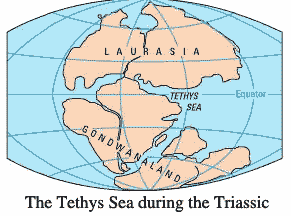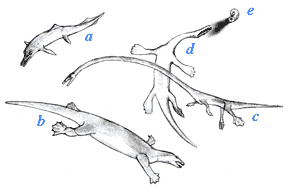
| Palaeos: |  |
Paleogeography |
| PALEOGEOGRAPHY | Tethys Sea |
| Page Back | Unit Up | Unit Home | Page Next | Paleogeography | Plate Tectonics |
 The Tethys was named in 1893 by the Austrian geologist Eduard Suess after
the Titan Tethys, the daughter of Uranus and Gaia, and the sister and consort of Oceanus, the ancient Greek god of the ocean.
It is perhaps more often referred to as the Tethys Ocean. However,
we prefer the former terminology, since "Tethys Ocean" is used by some
to refer only to the Paleo-Tethys (see below).
The Tethys was named in 1893 by the Austrian geologist Eduard Suess after
the Titan Tethys, the daughter of Uranus and Gaia, and the sister and consort of Oceanus, the ancient Greek god of the ocean.
It is perhaps more often referred to as the Tethys Ocean. However,
we prefer the former terminology, since "Tethys Ocean" is used by some
to refer only to the Paleo-Tethys (see below).
As
presently understood, there were actually at least two Tethys Seas. In Permian
times, the continents were -- roughly speaking -- assembled into one, enormous,
'C'-shaped landmass, known as Pangea. The
Paleo-Tethys was the body of water enclosed on three sides (and at times, almost
four sides) by Pangea. By the Early
Triassic, a long sea-floor spreading ridge developed along the southern
shore of the Paleo-Tethys. This extended all the way from Australia, at
the extreme southeast end of Pangaea, northwest to the point where the plates of
Europe, North America and Africa met -- roughly at the center of the 'C'.
As the sea floor spread, it created a basin bordered on the south and west by
the Gondwanan continental plates of the Pangean landmass (the bottom half of
the 'C') and on the north and east by  the new microplates of Tibet, Iran and
Turkey. These microplates were pushed rapidly northward towards Eurasia
and China, eventually closing the Paleo-Tethys. The new Tethys basin expanded
behind them to become the Mesozoic Tethys Sea. The
Tethys Sea also expanded westward, splitting Pangaea into the supercontinents
of Gondwana (in the South) and Laurasia
(in the North). By Late
Triassic and Jurassic
times, the Tethys extended a long, shallow arm through what is now Central Asia
and Southern Europe, known as the Tethys Seaway (yet a third
"Tethys"). This Seaway became the home of many unique marine reptiles;
mostly coastal and shallow water dwellers. Here are some drawn to
scale.
the new microplates of Tibet, Iran and
Turkey. These microplates were pushed rapidly northward towards Eurasia
and China, eventually closing the Paleo-Tethys. The new Tethys basin expanded
behind them to become the Mesozoic Tethys Sea. The
Tethys Sea also expanded westward, splitting Pangaea into the supercontinents
of Gondwana (in the South) and Laurasia
(in the North). By Late
Triassic and Jurassic
times, the Tethys extended a long, shallow arm through what is now Central Asia
and Southern Europe, known as the Tethys Seaway (yet a third
"Tethys"). This Seaway became the home of many unique marine reptiles;
mostly coastal and shallow water dwellers. Here are some drawn to
scale.
a, the ichthyosaur Mixosaurus (length about 1 metre)
b, the placodont Placodus (2.5 metres long)
c, the prolacertiform Tanystropheus
d, the sauropterygian
Nothosaurus
e, an ammonite, escaping by using its
ink
this drawing is © Professor Paul Eric
Olsen, from The
Triassic World page - from his DINOSAURS
AND THE HISTORY OF LIFE - GEOLOGY V1001x site
The Wikipedia entry on the Tethys has information similar to our entry. In fact we like their explanation better. You can find more details of the interaction between the Tethys Sea and the Paleo-Tethys in the Wikipedia entry on the Cimmerian Plate. Earth Science- Plate Tectonics Present to Cambrian contains numerous maps showing the evolution of the Tethys. However, the terminology used is a bit odd -- the authors attempt to distinguish four different Tethyan bodies. Some of the confusion is historical and derives from changes in geological concepts related to the advent of plate tectonics. This history is reviewed briefly at The ancient Tethys oceans of Asia- How many- How old- How deep ... (sadly the maps are not included). Another review, with a rather different set of ideas about the Tethys, may be found at Chapter 1- Introduction 1 Chapter 1 1. INTRODUCTION 1.1 Rationale.